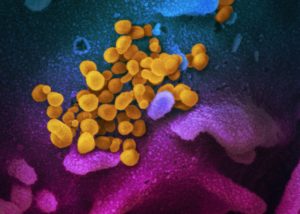Computational biologists dig into the origins of the single unique protein in the SARS-CoV-2 lineage
As the COVID-19 pandemic enters its second year, scientists are still working to understand how the SARS-CoV-2 strain evolved, and how it became so much more dangerous than other coronaviruses, which humans have been living alongside for millennia. Virologists and epidemiologists worldwide have speculated for months that a protein called ORF8 likely holds the answer, and a recent study by Berkeley Lab scientists has helped confirm this hypothesis.

In a paper published in mBio, lead author and DOE Joint Genome Institute (JGI) postdoctoral researcher Russell Neches and his colleagues show that ORF8 evolved from another coronavirus protein called ORF7a, and that both proteins have folds similar to that of a human antibody. This finding helps to explain how the virus avoids immune detection and is able to escalate into a severe infection in some hosts.
“By exploring the structural and functional characteristics of ORF8, and using supercomputers to look at the genomes of over 200,000 viruses, we discovered a striking and highly unusual evolutionary strategy,” said co-author Nikos Kyrpides, a computational biologist at the JGI. “Amazingly, it seems that within the SARS clade, the gene encoding ORF7a is used as a ‘template’ gene, remaining stable, with a duplicate copy of this gene evolving to a point almost beyond recognition.” SARS-CoV-2 arose and exploded into a pandemic when a SARS strain’s duplicate ORF7a gene happened to mutate leading to a new protein (which we now call ORF8) that gave it the ability to interfere with immune cells.
This Science Snapshot was published on the Berkeley Lab News Center.



